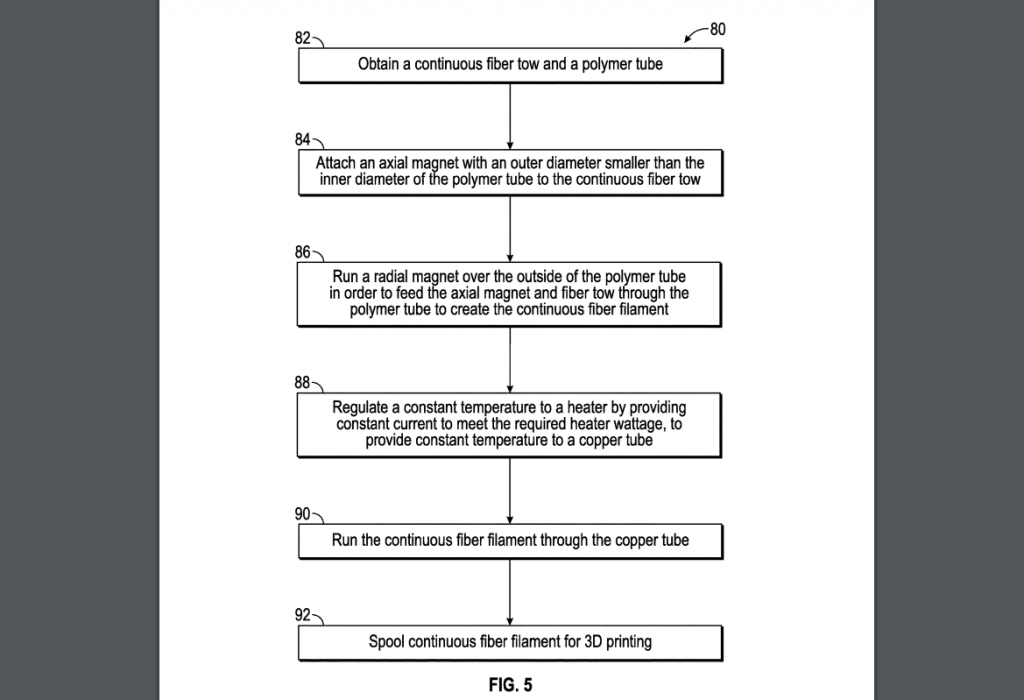In February this year you may remember an article detailing a composite 3D printer patent granted to American global defense company Northrop Grumman. Now it has a emerged that another team from the military-friendly company has been working on a 3D printable composite material.
As detailed by the abstract this recent patent, dated 19 February, 2019, the invention relates to, “A system and method for producing a uniform continuous fiber filament.” The method includes the use of magnets to feed the fiber creating “uniform continuous fiber filament.”

The interest in composite 3D printing
With the unique properties that composite materials provide it is not hard to imagine why Northrop Grumman would be investing in its development. In some cases, fiber-reinforced materials exhibit a strength comparable to metals, but they are a fraction of the weight, and the cost.
One leading composite 3D printer manufacturer is Markforged. For two years in a row its staple Mark Two 3D printer, which is capable of processing carbon fiber, fiberglass and Kevlar reinforced materials, has taken home the Enterprise 3D Printer of the Year (Polymers) award. Other notable names in this field include Impossible Objects, which raised $6.4 million in Series A funding a couple of years ago, and Fortify, the Digital Composite Manufacturing (DCM) startup that recently raised $2.5 million in seed funding.
Further establishing the clear value placed in composite materials by engineers and the 3D printing industry in general, last year leading OEM Stratasys launched its Fortus 380mc Carbon Fiber Edition (CFE).
Invention of a new material
The patent “Continuous fiber filament for fused deposition modeling (FDM) additive manufactured (AM) structures“(US10207426B2) was initially filed by Northrop Grumman Systems Corp in October 2015. It was then published in April 2017, before finally being granted in February 2019.
The inventors credited on the patent are Daniel J. Braley, Anthony M. Tamayo and Eric G. Barnes. Braley was a Senior Manufacturing Technology Development Engineer and Program Manager at Northrop Grumman the time the patent was filed, and Tamayo a Mechanical Engineer. Both have since moved on to roles at international aerospace company Boeing, with Braley now Additive Manufacturing Technical Focal for the company in St. Louis. Barnes on the other hand has worked for Northrop for almost three decades. Since October 2013, Barnes has been the company’s Additive Manufacturing Fellow, within the Aerospace System Sector. As part of this role, Barnes is responsible for integrating additive manufacturing throughout the company’s manufacturing processes.

Overcoming the challenges of other material manufacturing
Aiming to harness the superior strength of continuous carbon fiber materials (as opposed to those containing chopped fibers) the Northrop Grumman patent describes a kind of sheathing process for producing composite materials. In the method, the fiber is attached to a magnetic tow. A second hollow tube, composed of chosen polymer, is also attached to a magnet that runs around its circumference. Harnessing the forces between these two magnets, the method ensures that the fiber content is continuous, and uniformly fed through the polymer tube, to create a length of filament.
With this mehtod the team overcomes some of the challenges associated with other methods of filament fabircation. As explained in the discussion “Known methods to create a continuous fiber filament that includes a fiber tow with a resin thereon includes running the fiber tow through a bath of the molten resin and allowing the resin to harden around the fiber […] Typically these systems and processes are time – consuming and expensive. In addition , the process is difficult to control and there is a lack of uniformity in the resin that hardens around the fiber.”
“Thus, these is a need in the art for a reliable method to create uniform continuous fiber filaments that are suitable for FDM AM structures.”
Voting is now open for the 2019 3D Printing Industry Awards now. For more of the latest additive manufacturing research & development news, subscribe to our 3D printing newsletter. You can also join us on Facebook and Twitter.
Looking for a job in R&D? Visit our 3D Printing Jobs board.
Featured image shows a cross section of the system used to make the composite filament. Image via US10207426B2



